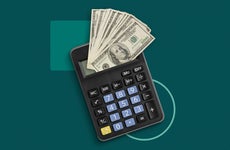How to convert factor rates to interest rates

The Bankrate promise
At Bankrate we strive to help you make smarter financial decisions. While we adhere to strict , this post may contain references to products from our partners. Here's an explanation for .
A factor rate is a multiplier that some lenders use to calculate the total cost of a business loan. This rate is used instead of an annual percentage rate (APR).
Factor rates are most common with bad credit and alternative types of business loans, such as merchant cash advances. These loans are typically short term, and they may come with additional fees that aren’t common to other business loans.
Unlike an APR, a factor rate doesn’t incorporate loan fees when determining the loan cost. Factor rates make it difficult to determine the true cost of a factor rate loan. You can more easily compare loan costs when you convert the factor rate to an annual interest rate.
How do factor rates work?
Factor rates are expressed as a decimal, usually between 1.10 or 1.50, which then gets multiplied by the amount you’re borrowing. The final amount is the cost of the loan, not including additional fees the lender may charge.
How to calculate a factor rate
Determine your loan’s total cost with this formula:
Principal loan amount x factor rate = total loan cost
Let’s say you get a loan for $75,000 with a 1.30 factor rate spread across 18 months. If you plug in the numbers, you would multiply $75,000 x 1.30 to get $97,500 as your total loan cost.
If you just want to know the cost you’ll be charged, you would subtract the amount borrowed from the total loan cost: $97,500 – $75,000 = $22,500.
Factor rates vs. interest rates
Factor rates are a fixed cost that doesn’t change over the life of a loan unless the lender offers an early payment discount to encourage you to pay the loan off early. They also don’t incorporate additional loan fees into the loan cost, such as origination or underwriting fees. So you would need to add those fees in to understand the total costs of the loan.
On the other hand, most loans use an annual percentage rate (APR) to represent the annual loan cost including certain fees. Because APR includes fees, it’s a more accurate picture of the loan’s cost than a factor rate.
With an APR, the interest gets added to the principal with each payment, which means that you can save money by paying the loan off early.
Convert factor rates to interest rates
To compare loans with factor rates and interest rates and ensure you’re getting the most affordable loan, find the annual interest charged for the factor rate loan.
Here’s how to convert factor rates to interest, using the example of a $75,000 loan with a factor rate of 1.30 repaid over 18 months.
Method one
1. Calculate the total loan cost by multiplying the amount borrowed by the factor rate:
$75,000 (amount borrowed) x 1.30 (factor rate) = $97,500 (total loan cost)
2. Subtract the total loan cost from the amount borrowed to see the interest charged:
$97,500 (total loan cost) – $75,000 (amount borrowed) = $22,500 (total interest charged)
3. Convert the interest charged to a percentage. To do that, divide the total interest charged by the amount borrowed:
$22,500 (total interest charged) / $75,000 (amount borrowed) = 0.30 (interest as a decimal)
4. Convert the total interest rate to an annual rate in two steps.
a) Multiply the decimal by the number of days in a year:
0.30 (interest as decimal) x 365 (days in a year) = 109.50
b) Then, divide by the number of days in the repayment term:
109.50 / 547.5 (days in 18-month term) = 0.20 (annual interest)
5. Change to a percentage by multiplying the decimal by 100:
0.20 (annual interest) x 100 = 20% (annual interest rate)
Method two
This method of converting a factor rate to an interest rate simplifies the steps used in method one. To do this:
1. Subtract 1 from the factor rate:
1.30 (factor rate) – 1.00 = 0.30
2. Multiply by 365 days in a year:
0.30 x 365 (days in a year) = 109.50
3. Divide the decimal by the number of days in your repayment term:
109.50 / 547.5 (days in repayment term) = 0.20 (interest as a decimal)
4. Multiply the decimal by 100 to get the annual interest rate:
0.20 (interest as a decimal) x 100 = 20% (annual interest rate)
Compare factor rates to interest rates
Now that we know a $75,000 with a factor rate of 1.30 converts to a 20 percent interest rate when paid off in 18 months, we can compare costs.
The $75,000 loan with a factor rate of 1.3 costs $22,500. Using a business loan calculator, here’s how much interest you’d pay and the total cost of a loan with an APR of 20 percent.
| Loan amount | $75,000 | $75,000 | $75,000 |
|---|---|---|---|
| Interest rate | 20% | 20% | 20% |
| Repayment period | 12 | 18 | 24 |
| Interest paid | $8,371.06 | $12,430.32 | $16,612.44 |
| Total cost | $83,371.06 | $87,430.32 | $91,612.44 |
As you can see, a loan with a comparable APR costs less than a loan with a factor rate. This is why you should shop around to see if you qualify for loans with a comparable APR before accepting a loan with a factor rate.
Paying the above factor rate loan off in 18 months gives you a comparable interest rate of 20 percent. But a 12-month repayment period is comparable to a 30 percent annual interest rate. And a six-month repayment period is comparable to a 61 percent annual interest rate.
When to take a loan with factor rates
The main reasons that you might take out a loan with factor rates are:
- It’s accessible to high-risk borrowers. Bad credit loans and alternative types of financing like merchant cash advances tend to use factor rates. These are aimed at helping borrowers who don’t qualify for traditional loans or who need fast funding.
- Costs are similar to loans with an APR. You might get a loan with a factor rate if you convert the factor rate to interest and find that the cost is similar to loans with an APR. But make sure to compare the factor rate loan with other loans to see if you can get a better rate or repayment terms.
Bottom line
Generally, business loans with a factor rate cost more in interest and fees than loans with an APR. Yet the only way to get an idea of the borrowing cost is to convert the factor rate to an annual interest rate.
The converted interest rate won’t compare directly to an APR, but it gives you a close comparison of interest charged minus loan fees.
Frequently asked questions
-
A high-risk business loan is a loan offered to a borrower with poor credit or payment history. These loans are typically offered through online or direct lenders, though some traditional banks accept businesses with bad credit. High-risk business loans tend to have high interest rates, such as 25.00 percent to 75.00 percent, and may have short repayment terms like 18 months.
-
To find the total loan cost with a factor rate, multiply the amount you’re borrowing by the factor rate, such as 1.10 or 1.40. The product is the amount borrowed plus interest charged.
-
Business loans that use factor rates are typically high-risk types of loans, such as merchant cash advances, some short-term and working capital loans.
Related Articles



